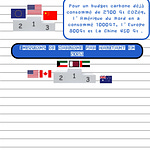The Earth's atmosphere naturally traps some heat, keeping our planet warm and habitable. This is called the greenhouse effect, and certain gases play a crucial role. However, human activities are increasing the concentration of these greenhouse gasses (GHGs) in the atmosphere, leading to global warming.
The Kyoto Protocol, an international treaty signed in 1997, aimed to tackle this issue. It focused on regulating six key GHGs, each with varying effects:
Carbon Dioxide (CO2): The main culprit, CO2 is emitted from burning fossil fuels like coal, oil, and gas. It's the reference point for measuring the impact of other GHGs.
Methane (CH4): Released from agriculture (livestock), waste decomposition, and fossil fuel production, methane traps significantly more heat than CO2 over a 20-year timeframe. However, it breaks down faster, impacting the atmosphere for a shorter period.
Nitrous Oxide (N2O): This gas arises from agricultural practices using fertilizers and from industrial processes.Similar to methane, it has a high heat-trapping ability but breaks down in the atmosphere over a longer timeframe compared to methane.
Hydrofluorocarbons (HFCs), Perfluorocarbons (PFCs), and Sulfur Hexafluoride (SF6): These industrial gases are used in refrigeration, air conditioning, and electrical applications. While their concentration in the atmosphere is lower than other GHGs, they have an incredibly high heat-trapping ability and persist for thousands of years.
Why the Difference?
Two key factors differentiate the impact of GHGs:
Radiative Efficiency: This refers to how effectively a gas traps heat. Methane, for example, is more efficient at trapping heat than CO2.
Atmospheric Lifetime: This indicates how long a gas stays in the atmosphere before breaking down. While CO2 persists for centuries, some HFCs can last for thousands of years.
The Kyoto Basket:
Understanding these differences was crucial for the Kyoto Protocol. The treaty focused on reducing emissions of all six GHGs, but with different targets based on their relative impact.
For example, reducing 1 ton of methane emissions has a much more significant effect on near-term warming potential compared to reducing 1 ton of CO2. The Kyoto Protocol established a system called the "basket approach," allowing countries to trade emission allowances for different gases based on their equivalency in terms of heat-trapping ability.
The Takeaway:
While all GHGs contribute to global warming, they don't do it equally. The Kyoto Protocol recognized these differences by regulating a basket of key gases and establishing mechanisms for comparing their impacts. Understanding these variations is crucial for developing effective strategies to combat climate change.





















Do all the GHG have the same effects?